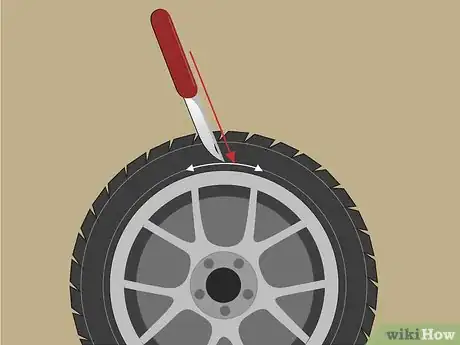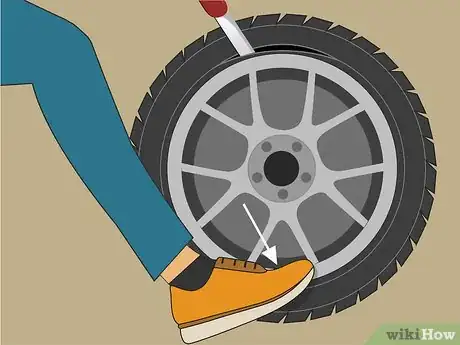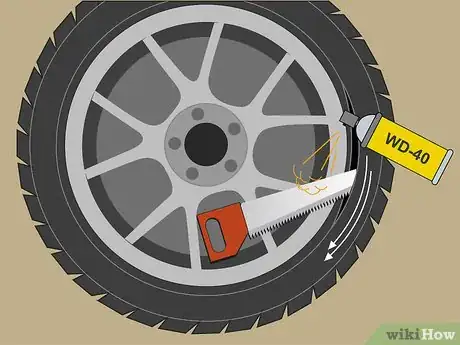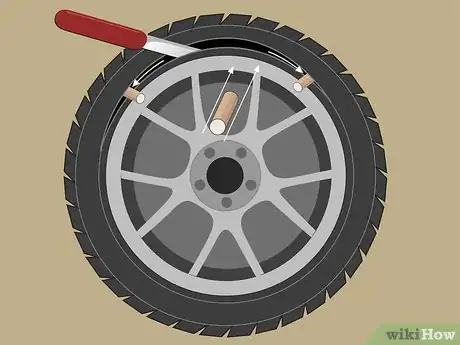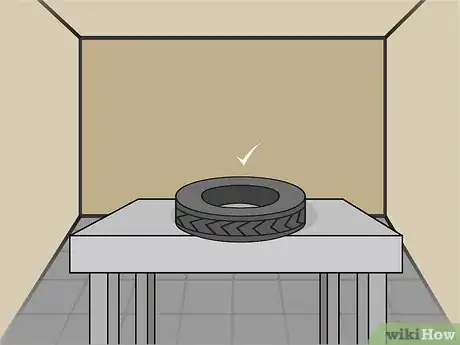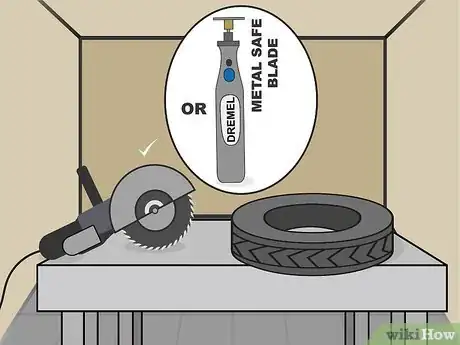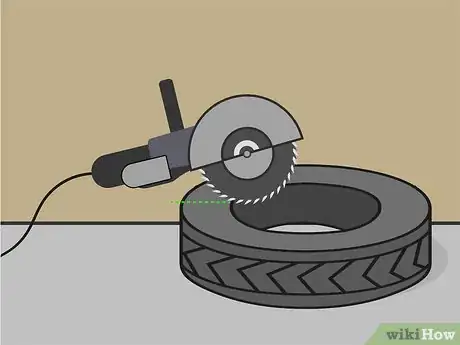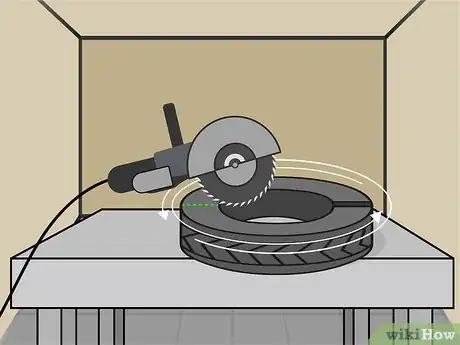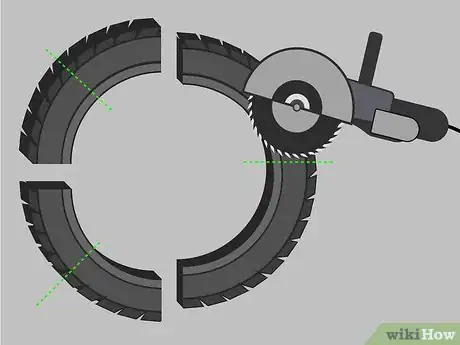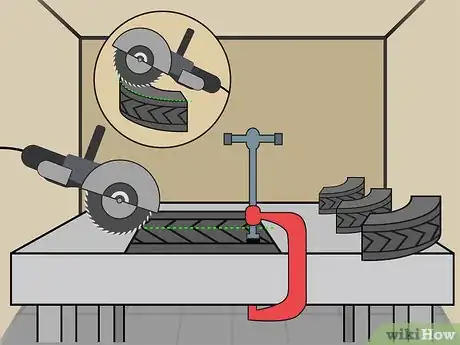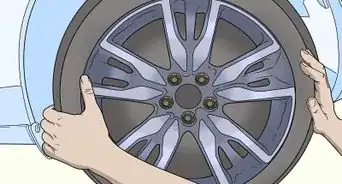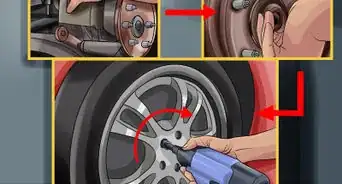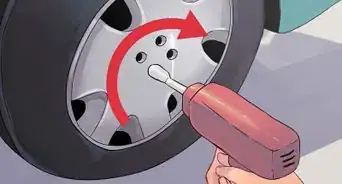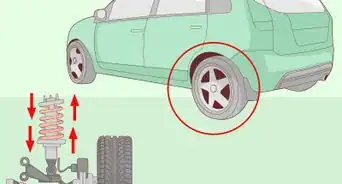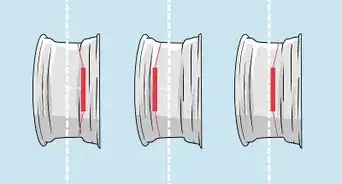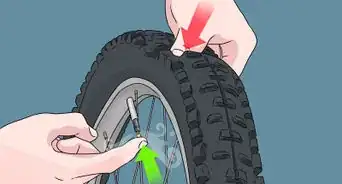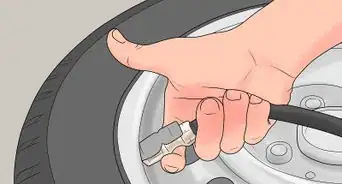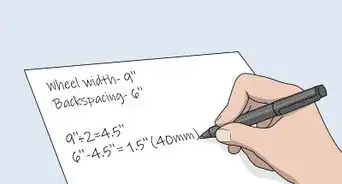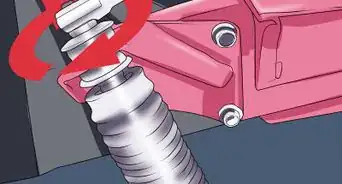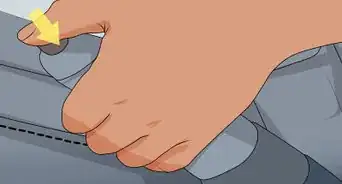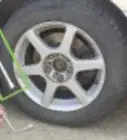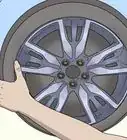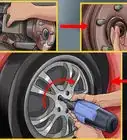This article was co-authored by Ed Beery. Ed Beery is an Automotive Specialist and the Owner of InTechgrity Automotive Excellence based in Denver, Colorado. With more than eight years of experience, he specializes in providing maintenance and repair services for both individuals and companies. Ed and the InTechgrity Automotive Excellence Team are approved by the American Automobile Association (AAA) for repairs and are Automotive Service Excellence (ASE) certified.
There are 13 references cited in this article, which can be found at the bottom of the page.
This article has been viewed 133,984 times.
Sometimes it's necessary to cut tires in order to dispose of them properly. Since tires are fashioned from thick, durable rubber, you'll need the right tools to get through them. You can remove the sidewall from a standard tire with a sharp knife by cutting along the seam just outside the tread, being careful not to bring the blade too close to the tread itself. To reduce a tire to more manageable pieces, you’ll need to equip yourself with a high-powered cutting tool, such as a circular saw or dremel, that’s been fitted with a blade that’s safe for use on metals.
Steps
Removing the Sidewall
-
1Puncture the sidewall close to the tread with a sharp knife. A utility knife or retractable box cutter will do the best job of slicing through the thick tire rubber. Thrust the tip of the blade straight into the smooth surface of the rubber about 1 inch (2.5 cm) from where the tread begins. Be careful not to cut too close to the tread itself, as it may be reinforced with steel belts.
- If you’re having trouble getting your initial hole started, grab an awl, ice pick, or similar tool with a sharp, pointed tip.[1]
- Attempting to cut directly through steel belts by hand could dull or damage your cutting implement, or result in a lot of wasted effort.
-
2Brace the tire with your foot or knee. Place the sole of your foot onto the lower section of the tire, or kneel down and pin it to the ground with one knee. This will prevent the tire from rocking or shifting once you begin cutting.
- To avoid an accident, make sure you only rest your foot or knee on a section of the tire you’re not actively cutting.
Advertisement -
3Cut along the outside the tread with a sawing motion. Use your free hand to steady the tire as you work the blade smoothly through the rubber of the sidewall. Follow the seam running alongside the thicker tread.[2]
- For maximum leverage and control, position the knife with the blade pointing towards you and slowly guiding it down between your legs.
- If you’re in a hurry, you can also use a jigsaw or dremel tool with a cutting blade attachment to speed up the process.[3]
Tip: Spray your knife with WD-40 or a similar lubricant to cut down on the friction created by the rubber.
-
4Use a wooden dowel to keep the cut sections separated. Insert one end of the dowel into the split tire and pull up on it sharply. Doing so will pry apart the rubber on both sides, making it easier to continue working without your blade becoming stuck or veering towards the tread.[4]
- Holding the cut sections open with a dowel as opposed to your own hand will also make you less likely to accidentally cut yourself.
-
5Rotate or move around the tire to complete the cut. Once you’ve finished cutting the upper ⅓-½ of the sidewall, pause and either turn the tire one-half rotation or walk around it until you’re in a good position to continue. Bring your blade all the way back around to the original start position, then pull the sidewall material free.
- Most waste disposal services won’t pick up old tires unless they’ve had the sidewalls removed.[5] Not only are they more unwieldy when left intact, it’s also possible for water and other substances to collect inside.
- If you want to repurpose your tire rather than throwing it away, consider turning it into a garden hose caddy, miniature in-ground pond, or quaint planter for your yard or garden.[6]
Cutting Tires into Smaller Pieces
-
1Do your cutting in a workshop or open outdoor space. Sawing tires can be tricky, and has a tendency to leave behind lots of small rubber and metal fragments. To ensure that you’re working as safely, efficiently, and neatly as possible, situate your tire on a workbench or series of sawhorses, or place it on the ground outside.
- When you’re done, simply sweep the materials into a dustbin and dispose of them.
- You may need an extension cord if there are no outlets available near your outdoor work space.[7]
-
2Fit a power saw or dremel tool with a metal-safe blade. Most large tires are threaded with supportive steel belts, which means it’s important to use a blade that’s capable of cutting through metal. Ferrous-metal blades are recommended for circular and jigsaws, while metal grinding blades will provide the most cutting power for dremel tools.[8]
- If you need to cut a lot of tires, invest in a set of carbide-toothed saw blades. Carbide blades make cleaner cuts and hold their edge far longer than ordinary varieties.[9]
- You might also be able to get through a tire using a hacksaw, if you don’t mind the exercise.
-
3Start your first cut widthwise through one side of the tire. Lay the tire flat on its side on your work surface and switch on your saw or dremel tool. Press the cutting edge into the upper surface of the tire laterally, or across the sidewall. Slowly move the tool from the inner edge to the outer edge, stopping at or just short of the tread.[10]
- You may encounter a little resistance from the steel belts circling the tire’s inner edge. Don’t worry—as long as you selected the right type of blade, you should be able to saw through the tire with relative ease.
- If you’re going to be cutting the tire in several places, go ahead and make all your cuts on the first side at once to save time.
Warning: It’s a good idea to put on a pair of safety glasses just in case any steel shards go flying out of the tire casing unexpectedly.
-
4Turn the tire over and complete the cut from the opposite side. Line up your tool with the end of the cut you just made on the first side and complete the cut on the second side. Work slowly and carefully and remember to take your time whenever you come to a steel or nylon vein.[11]
- Dividing the tire into halves allows you to cut faster and easier than you could by trying to force your cutting tool through both sides at once. It also helps you avoid causing unnecessary damage to your work surface.
-
5Make any other necessary cuts using the same procedure. Once you've cut the tire in half, rotate the resulting pieces 90 degrees and start another pair of cuts through the center on both sides. You can continue in this fashion until you've reduced the tire to quarters or even smaller sections.
- Steady the tire carefully for follow-up cuts. As the pieces grow smaller, they'll become more prone to sliding or shifting on your work surface.
- Most municipal disposal guidelines require that tires be cut into a minimum of 2 pieces.[12]
-
6Cut through the tread separately if you're having trouble. It may be hard to get through the tread of a particularly big tire if you’re coming at it from the side. What you can do in this case is cut both sides of the tire, then stand it up and make one final cut directly into the tread. When the 3 cuts intersect, the rubber should come apart without difficulty.[13]
- If possible, secure the tire with a vice or adjustable clamp. Otherwise, pinching it between your thighs will help to hold it in place.
- Be extremely cautious while operating your cutting tool, and make sure you keep it a safe distance away from your body at all times.
Community Q&A
-
QuestionWhat is the best tool to cut a tire?
 Drew Hawkins1Community AnswerThe best cutting tool to use for a tire is a utility knife or a retractable box cutter. It'll do the best job of cutting through the thick tire rubber. However, if you're having trouble penetrating the tire, you can get your initial hole started by using the pointed tip of an awl, ice pick, or a similar tool and poking it into the tire. You can also try using another type of knife. Just make sure it's tight. Also, avoid trying to cut through steel belts. Attempting to cut directly through steel belts by hand could dull or damage your cutting implement, or result in a lot of wasted effort.
Drew Hawkins1Community AnswerThe best cutting tool to use for a tire is a utility knife or a retractable box cutter. It'll do the best job of cutting through the thick tire rubber. However, if you're having trouble penetrating the tire, you can get your initial hole started by using the pointed tip of an awl, ice pick, or a similar tool and poking it into the tire. You can also try using another type of knife. Just make sure it's tight. Also, avoid trying to cut through steel belts. Attempting to cut directly through steel belts by hand could dull or damage your cutting implement, or result in a lot of wasted effort. -
QuestionHow do you cut tires at home?
 Drew Hawkins1Community AnswerStart by puncturing the sidewall close to the tread with a sharp knife such as a utility knife or boxcutter. Brace the tire by placing the sole of your foot onto the lower section of the tire, or kneel down and pin it to the ground with one knee. This will prevent the tire from rocking or shifting once you begin cutting. Cut along the outside of the tread using a sawing motion. Use your free hand to steady the tire as you work the blade smoothly through the rubber of the sidewall. Follow the seam running alongside the thicker tread. Use a wooden dowel to keep the cut sections separated. Once you’ve finished cutting the upper ⅓-½ of the sidewall, pause and either turn the tire one-half rotation or walk around it until you’re in a good position to continue. Bring your blade all the way back around to the original start position, then pull the sidewall material free.
Drew Hawkins1Community AnswerStart by puncturing the sidewall close to the tread with a sharp knife such as a utility knife or boxcutter. Brace the tire by placing the sole of your foot onto the lower section of the tire, or kneel down and pin it to the ground with one knee. This will prevent the tire from rocking or shifting once you begin cutting. Cut along the outside of the tread using a sawing motion. Use your free hand to steady the tire as you work the blade smoothly through the rubber of the sidewall. Follow the seam running alongside the thicker tread. Use a wooden dowel to keep the cut sections separated. Once you’ve finished cutting the upper ⅓-½ of the sidewall, pause and either turn the tire one-half rotation or walk around it until you’re in a good position to continue. Bring your blade all the way back around to the original start position, then pull the sidewall material free. -
QuestionCan you cut a tire with a chainsaw?
 Drew Hawkins1Community AnswerA chainsaw can be a useful tool for cutting up rubber tires into smaller chunks so they're easier to transport for disposal. Use caution when you're using a chainsaw and slice all the way through the rubber without stopping the blade so it doesn't get stuck. However, don't use a chainsaw to remove a tire from the rim. You could easily damage the rim, or worse, injure yourself. Instead, use a small, sharp knife such as a utility knife or a retractable box cutter. That way, you can more precisely cut the tire and avoid potentially injuring yourself.
Drew Hawkins1Community AnswerA chainsaw can be a useful tool for cutting up rubber tires into smaller chunks so they're easier to transport for disposal. Use caution when you're using a chainsaw and slice all the way through the rubber without stopping the blade so it doesn't get stuck. However, don't use a chainsaw to remove a tire from the rim. You could easily damage the rim, or worse, injure yourself. Instead, use a small, sharp knife such as a utility knife or a retractable box cutter. That way, you can more precisely cut the tire and avoid potentially injuring yourself.
Warnings
- The exposed steel belts inside the cut tire will be very sharp, so avoid touching them.⧼thumbs_response⧽
- Keep in mind that tires can’t be resold once they’ve been cut.⧼thumbs_response⧽
- Cutting tires is hard and requires steady hands. Sometimes, your best bet is to take the tires to a tire shop, an auto repair shop, or a recycling center.⧼thumbs_response⧽
Things You’ll Need
Removing the Sidewall
- Sharp knife (utility knife, box cutter, etc.)
- Wooden dowel
- WD-40 or similar lubricant (optional)
- Awl or ice pick (optional)
Cutting Tires into Smaller Pieces
- Circular saw, jigsaw, or dremel tool
- Ferrous-metal blade or metal grinding blade
- Safety glasses
- Vice or adjustable clamps (optional)
- Workbench or sawhorses (optional)
References
- ↑ https://www.youtube.com/watch?v=7jrrqmz9j00&t=46s
- ↑ https://www.youtube.com/watch?v=5X0IGufgYdQ&t=13s
- ↑ https://www.youtube.com/watch?v=1C8qHfJMMS8&t=94s
- ↑ https://www.youtube.com/watch?v=7jrrqmz9j00&t=67s
- ↑ https://dnr.mo.gov/waste-recycling/reduce-reuse-recycle/what-to-do-with-specific/scrap-tires
- ↑ https://www.diyncrafts.com/5863/repurpose/20-genius-ways-repurpose-old-tires-something-new-exciting
- ↑ https://www.ccohs.ca/oshanswers/safety_haz/power_tools/saf_elec.html
- ↑ https://www.familyhandyman.com/workshop/10-easy-ways-to-cut-metal-fast/view-all/
- ↑ https://www.lowes.com/n/buying-guide/circular-saw-blade-buying-guide
About This Article
If you have to cut a tire, you’ll need a sharp utility knife or box cutter. To remove the sidewalls, puncture the smooth rubber near the tread and cut along it with a sawing motion. To prevent the tire from moving while you cut it, support it with your foot or knee on the opposite side to where you’re cutting. Insert wooden dowels to keep the cut sections separated while you work. If you want to cut your tire into smaller pieces, use a power saw or dremel tool with a metal-safe blade. Secure the tire with a vice or adjustable clamp if you have one. For more tips, including how to dispose of a cut tire, read on!
